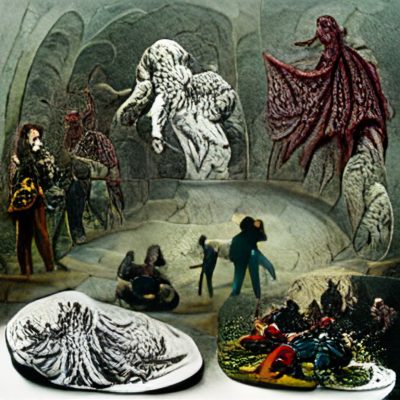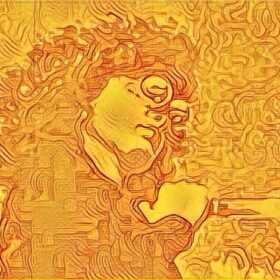13th Age
Monster Rituals
 Sometimes, a monster’s just a bag of hit points attached to some fun attacks – the heroes roll in, spend a few perfectly enjoyable combat rounds fighting the creature, and then head on to the next encounter.
Sometimes, a monster’s just a bag of hit points attached to some fun attacks – the heroes roll in, spend a few perfectly enjoyable combat rounds fighting the creature, and then head on to the next encounter.
Sometimes, a monster’s a major recurring foe, a devilish nemesis whose schemes and counterschemes reverberate through the campaign, who clashes with the player characters again and again.
And here’s the tricky part – you don’t always know what role a monster will play in your campaign when you create it. Sometimes, a relatively minor foe – that randomly rolled manticore, or maybe Ogre Bodyguard #3 who happened to land a decisive crit on the paladin – will be elevated by circumstance into a recurring villain. (In one Temple of Elemental Evil campaign I ran, for example, a demon henchman happened to survive an encounter where the player characters slew the demon-summoner and a bunch of other minions. That demon lurked around the Village of Hommlet in disguise for months of game time, causing far more trouble for the characters using her non-combat magic than she ever could have inflicted with regular attacks).
I Never Knew He Could Do That… But I Should Have Guessed
Instead of adding lots of new rules and templates, or weighing monsters down with a stack of minor spellcasting abilities that may never come up, let’s go with a typically loose-n-thematic 13th Age approach and adapt the Ritual rules. A monster can perform a ritual powered by:
- Giving up one of its special abilities until after the next fight with the player characters
- A campaign loss incurred by the player characters
- Some magical sacrifice or other way of gathering mojo (a way the characters could thwart if they act in time – the heroes learn that the evil necromancer is heading for an ancient graveyard; if they stop him from tapping the graveyard for power, they stop his ritual).
Optionally, you could also bundle a few results of 5 on Icon rolls together as permission for a monster ritual, if you can’t think of a good complications.
The key for a good Monster Ritual is keeping it thematic; the effects of the ritual should be clearly inspired by the monster’s existing abilities and attributes.
Ritual Effects
Like regular rituals, Monster Rituals aren’t direct attacks – they’re story elements. The monster might discover vital information through scrying, cast curses or charms on major Non-Player Characters, overwhelm magical defences, and other regular evil-doer stuff. If mechanical effects are warranted, consider:
- Forcing player characters to make skill checks/employ their own rituals to overcome an obstacle (“the troglodyte shaman’s conjured up a stinking fog! How do we get past?”)
- Summoning minions, making the next fight a bit harder (“oh no! The necromancer’s called up a bunch of wraiths!”)
- Preventing the player characters from using one of their magic items or go-to abilities (“Nay! The demon has cursed my magic armour and now it burns with the flames of hell! I cannot wear it without burning mine own nether regions!”).
If you do stop the players from using one of their class abilities, let them swap in another power. So, if a rival wizard uses a ritual to prevent anyone from casting confusion in his dungeon, make sure your confusion-loving player character wizard has a chance to prepare another spell to replace it.
Sample Monster Rituals
Warp-Pulse Ritual (Hungry Star): Curses a whole region with low-level psychic damage (1 point/day, but it’s enough to trigger the star’s bonus nastiness). And, of course, all those 5hp peasants are in big trouble…
Hunting Rights (Manticore): Magically reinforces the manticore’s claim on the right to hunt humans, letting it steal Emperor-relationship iconic benefits. Whenever anyone rolls a 5 or 6 on their Emperor relationship, it goes to the manticore instead, and can be used to fuel…
Poison-Bolstering Rite (Manticore): This rite protects the manticore from its own poison reservoirs trait, ensuring it doesn’t take damage from its volley of tail spikes attack.
Blackamber Summoning (Blackamber Skeleton): Conjures more Blackamber Skeleton Legionnaires, making fights in the dungeon tougher with each casting of the ritual.
Drider Curse (Drider): The blasphemous rite that turns a drow into a full-fledged drider. Unless the player characters can stop the drider from finishing the rite, they’ll face two driders instead of one!
Lightning Web (Drider): Charges regular spider-webs with dangerous electrical energy. The web-choked corridors of the dungeon are now lethal traps (DC20 to spot; 2d12 electrical damage if touched)
.
Frenzied Seas (Sahuagin): Infusing their own ferocity into the waves, the sahuagin ritual whips up a wild storm, forcing all sailors to make skill checks to avoid foundering.
13th Age combines the best parts of traditional d20-rolling fantasy gaming with new story-focused rules, designed so you can run the kind of game you most want to play with your group. 13th Age gives you all the tools you need to make unique characters who are immediately embedded in the setting in important ways; quickly prepare adventures based on the PCs’ backgrounds and goals; create your own monsters; fight exciting battles; and focus on what’s always been cool and fun about fantasy adventure gaming. Purchase 13th Age in print and PDF at the Pelgrane Shop.


